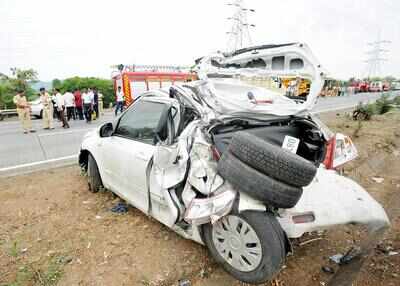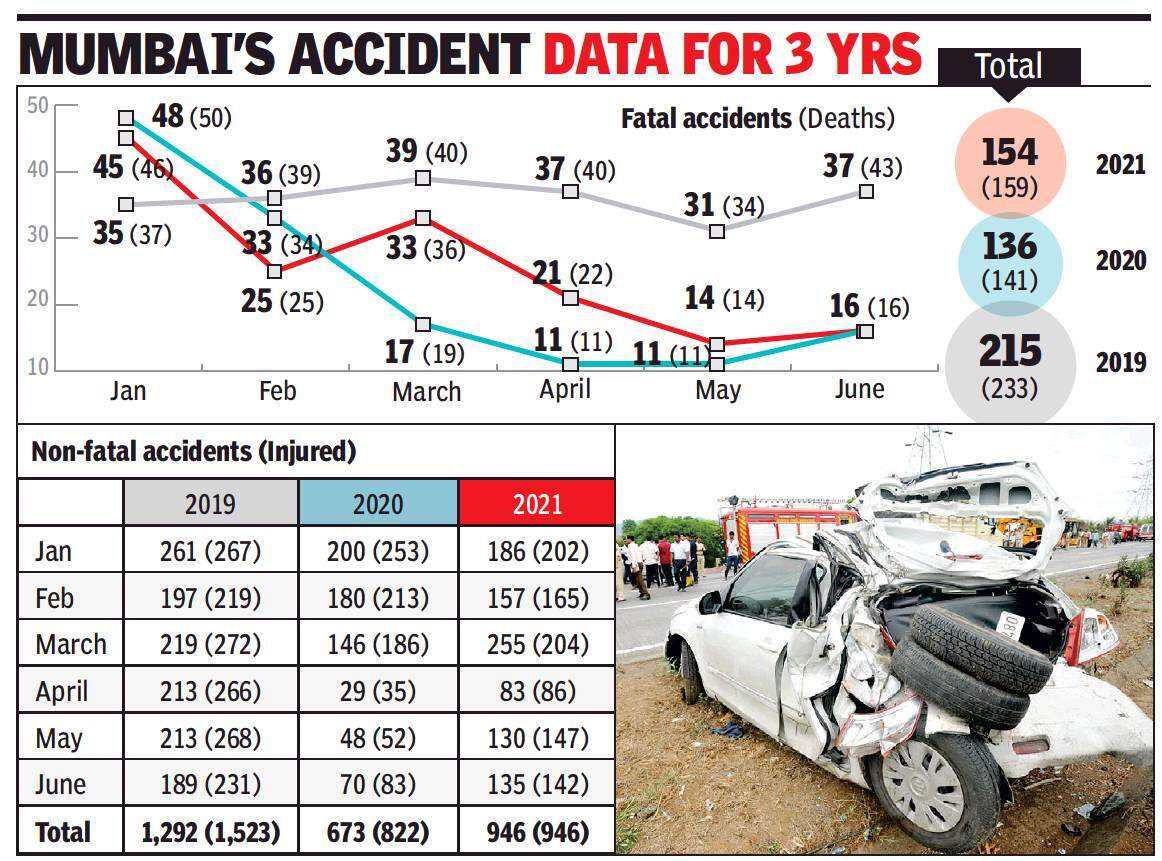Top Searches
- News
- City News
- mumbai News
- Road crashes & fatalities climb again after 2020 lockdown slump in Mumbai
Road crashes & fatalities climb again after 2020 lockdown slump in Mumbai

Representative Image
MUMBAI: Road crashes and fatalities on city roads have picked up again this year after a lull during the 2020 lockdown.
Deaths due to accidents dipped by 39% from 233 in January-June 2019 to 141 in the same period in 2020. But in the first six months of 2021, the number of road crash deaths rose to 159—a 13% upswing—which enforcement agencies attribute to higher pedestrian and vehicular movement compared to the full lockdown.

With increasing need for social distancing, restricted railway travel, and the continuing pandemic crisis, Mumbai must make a conscious effort to promote a mode shift to walking and cycling, instead of prioritising cars, said experts.
“With an increase in private vehicles on roads post-lockdown, it is imperative that Mumbai adopts electronic enforcement to nab offenders. The other challenge is that revised traffic penalties are yet to be implemented in Maharashtra,” said road safety expert Piyush Tewari.
According to police data, non-fatal crashes have surged by 41% from 673 in January-June 2020 to 946 this year. Road crashes impose a severe economic burden on the survivors, particularly for lower-income groups. A latest World Bank report showed that the financial loss for the poor amounted to more than seven months’ household income, while it was equivalent to less than one month’s income for rich households.
“Good street design is the best tool to enforce safe speeds and reduce crashes. Mumbai can start to widen pedestrian infrastructure through simple measures like curb extensions and wider sidewalks which not only allow more space for social distancing, but also increases visibility for all road users,” said urban designer Abhimanyu Prakash, who has worked on projects for safer streets under the Bloomberg Initiative for Global Road Safety. “Cities worldover are starting to invest more in public transport by increasing the number of buses and their frequency. Using school buses while schools remain closed is also a great way to increase bus service,” he added.
With lockdown restrictions easing, Delhi too saw a spike in fatalities this year. The administration has started to train the police in basic trauma care skills to provide onsite care to victims, and re-train bus drivers. “Ambulance response time is being brought down from 55 minutes to 20,” said Tewari, whose NGO is partnering with the administration.
“Bogota, London and Paris are examples of how urban mobility is being rethought with a rapid rollout of low-cost walk-ing and cycling infrastructure. Cities like Kochi and Bengaluru are creating better footpaths and cycle tracks that Mumbai could learn from,” said Arnab Bandyopadhyay, lead transport specialist with World Bank.
Deaths due to accidents dipped by 39% from 233 in January-June 2019 to 141 in the same period in 2020. But in the first six months of 2021, the number of road crash deaths rose to 159—a 13% upswing—which enforcement agencies attribute to higher pedestrian and vehicular movement compared to the full lockdown.

With increasing need for social distancing, restricted railway travel, and the continuing pandemic crisis, Mumbai must make a conscious effort to promote a mode shift to walking and cycling, instead of prioritising cars, said experts.
“With an increase in private vehicles on roads post-lockdown, it is imperative that Mumbai adopts electronic enforcement to nab offenders. The other challenge is that revised traffic penalties are yet to be implemented in Maharashtra,” said road safety expert Piyush Tewari.
According to police data, non-fatal crashes have surged by 41% from 673 in January-June 2020 to 946 this year. Road crashes impose a severe economic burden on the survivors, particularly for lower-income groups. A latest World Bank report showed that the financial loss for the poor amounted to more than seven months’ household income, while it was equivalent to less than one month’s income for rich households.
“Good street design is the best tool to enforce safe speeds and reduce crashes. Mumbai can start to widen pedestrian infrastructure through simple measures like curb extensions and wider sidewalks which not only allow more space for social distancing, but also increases visibility for all road users,” said urban designer Abhimanyu Prakash, who has worked on projects for safer streets under the Bloomberg Initiative for Global Road Safety. “Cities worldover are starting to invest more in public transport by increasing the number of buses and their frequency. Using school buses while schools remain closed is also a great way to increase bus service,” he added.
With lockdown restrictions easing, Delhi too saw a spike in fatalities this year. The administration has started to train the police in basic trauma care skills to provide onsite care to victims, and re-train bus drivers. “Ambulance response time is being brought down from 55 minutes to 20,” said Tewari, whose NGO is partnering with the administration.
“Bogota, London and Paris are examples of how urban mobility is being rethought with a rapid rollout of low-cost walk-ing and cycling infrastructure. Cities like Kochi and Bengaluru are creating better footpaths and cycle tracks that Mumbai could learn from,” said Arnab Bandyopadhyay, lead transport specialist with World Bank.
FacebookTwitterLinkedinEMail
Start a Conversation
end of article

